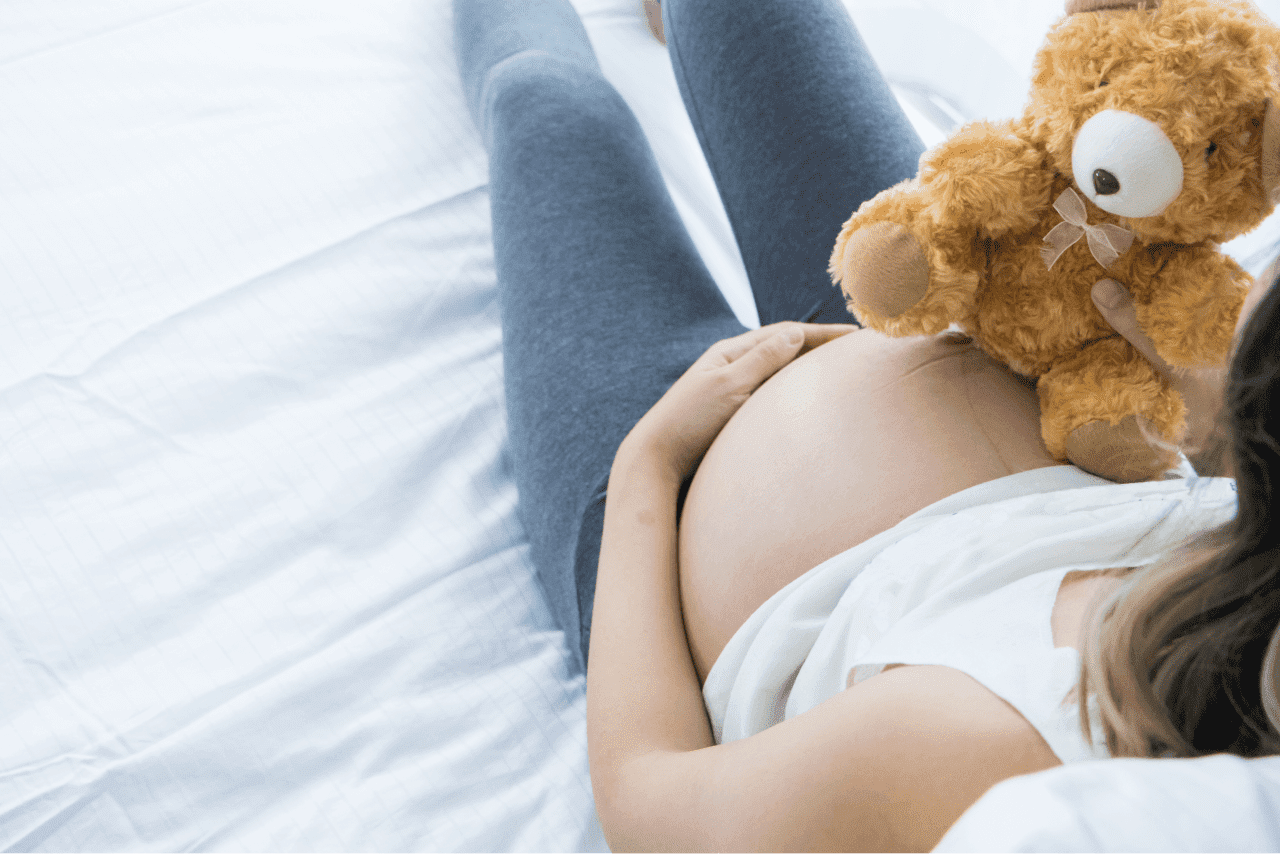Myth 1: Pregnant women need to eat twice as much.
Absolute myth. Don’t do it. You really actually only need about 300-400 extra calories a day after the first trimester. And that’s assuming that you’re starting pregnancy at a normal weight.
Overeating can be harmful to both the woman and the fetus, especially if the diet contains a lot of empty calories.
Women should aim for a gradual increase in calories throughout the pregnancy:
- First trimester: No extra calories are necessary.
- Second trimester: Experts recommend an additional 340 calories per day.
- Third trimester: An additional 400-450 calories per day is the recommendation.
Women should generally focus on continuing with their regular diet, but they should ensure that they are eating nutrient-rich foods.
Myth 2: It’s OK to drink a glass of wine when you’re pregnant.
Unfortunately, there is no safe amount of alcohol nor a safe time in pregnancy when we can be sure that alcohol won’t affect a developing fetus.
A 2007 meta-analysis confirmed that low to moderate alcohol consumption during pregnancy is not associated with adverse neonatal or child outcomes. However, as a result of possible methodologic flaws in these studies, it cannot be concluded for certain that alcohol consumption at this level during pregnancy is safe. Therefore, all major health organizations recommend abstaining completely from alcohol during pregnancy.
Also, I think it’s important to add that it is not safe to drink while you’re breastfeeding, either, because the alcohol does get into breast milk. We don’t know what the safe amount is, and that safe amount may actually change for different women.
Myth 3: Cocoa butter prevents stretch marks.
«Cocoa butter prevents stretch marks.» This is a myth. While cocoa butter is something that many patients like to use, we don’t have any evidence that cocoa butter or anything else that we can recommend will prevent stretch marks.
It’s probably genetic, and, essentially, if you gain too much weight in one spot, i.e. your pregnancy gets really big, you’re more likely to get stretch marks, unfortunately. Therefore, investing into a very expensive cream would not be very useful if you have significant amount of weight gain or you are genetically predisposed to stretch marks.
Myth 4: You can give a cold to your developing baby.
«You can give a cold to your developing baby.» This is a complete myth. Your baby is not going get the cold. Although your baby can get sick if you get something like the flu, which is why it is advisable for pregnant women to have influenza vaccination to prevent your baby from getting really sick. There are some illnesses you can transfer to your baby, but probably not a cold. It is important not to confuse a common cold and influenza (the flu) the flu confused, because “the flu “can make you really sick in pregnancy.
Myth 5: Pregnant women shouldn’t drink coffee.
This is a myth. You can drink coffee. This is one where moderation is the most important thing. In the first trimester, having excessive amounts of coffee have been associated with a higher risk of miscarriage.
Once that first trimester is over, should you go crazy with the coffee? Probably not.
According to the American obstetrics and Gynaecology association, you can consume below 300mg caffeine a day, which is equivalent to : Low-to-moderate caffeine intake in pregnancy does not appear to be associated with any adverse outcomes.
Pregnant women may have caffeine but should probably limit it to less than 300 mg/d (a typical 8-ounce cup of brewed coffee has approximately 130 mg of caffeine. An 8-ounce cup of tea or 12-ounce soda has approximately 50 mg of caffeine), but exact amounts vary based on the specific beverage or food.
Myth 6: Pregnant women shouldn’t eat smoked salmon.
This a myth. You can eat smoked salmon if you like it.
There are a lot of concerns around fish consumption in pregnancy, which is a huge topic. And I talk to my patients about the risk of various types of fish. Women should try to consume two to three servings per week of fish high in docosahexaenoic acid and omega-3 long-chain polyunsaturated fatty acids and low in mercury. These fish include anchovies, Atlantic herring, Atlantic mackerel, mussels, oysters, farmed and wild salmon, sardines, snapper, and trout. Other fish or seafood that have low mercury are safe, but might not provide high amounts of docosahexaenoic acid. These include shrimp, pollock, tilapia, cod, and catfish. Women should avoid fish with high mercury content, including king mackerel, shark, swordfish, marlin, and tilefish. The mercury content of commercial fish can be found here.
Regarding Raw and undercook fish/sushi—Most health organizations advise women to avoid raw and undercooked fish during pregnancy. The concern is the result of the risk of foodborne illness such as bacteria or parasites. However, the fish that typically make up sushi (tuna, salmon, yellow tail, snapper, flounder) rarely carry parasites aside from possibly Anisakis or Diphyllobothrium latum (fish tapeworm), which are uncommon in developed countries and are also not particularly dangerous. Therefore, the risk of infection from sushi in developed countries is likely not significant.
Myth 7: Pregnant women shouldn’t pet cats.
This is a myth. It would be terrible if all pregnant women in the world couldn’t pet their pets, their cats!
There is a concern with pregnant women caring for cats in terms of the litter box, and really the risk is toxoplasmosis. And the risk of exposure isn’t with interacting with your cat, but with changing a dirty litter box. It is actually fairly rare in Singapore for pregnant women to come into contact with toxoplasmosis by coming in contact with cat litter.
Cat feces can carry toxoplasmosis, a potentially harmful disease. As a precaution, therefore, a pregnant woman should either wear gloves to change the litter, wash their hands thoroughly after clearing the cat litter or have someone else do it.
Women do not need to avoid cats during pregnancy as long as they follow this precaution.
Myth 8: Pregnant women shouldn’t fly.
This is a myth. Having said this, there are a few things to think about when flying. I think one of the major issues is that pregnant women are at increased risk for getting a blood clot either in their leg or their lung. When you fly, the air is dry. You’re also more likely just to be sitting for a prolonged period of time. And that just further increases your risk for getting a blood clot. So, I always tell my patient to ensure she is adequately hydrated. You should wear support hose or at least, like, you know, running tights or something that gives you a little bit of support in your legs. You should get up and walk around every hour or so. Some people worry about the air pressure, which makes no sense because it’s a pressurized cabin and this is not going to cause the amniotic sac to break.
Another big concern is cosmic radiation. Study have shown that this is below the threshold level for fetal concerns. Pregnant women may go through security metal detectors as well. The radiation exposure from the newer backscatter units is 5 microrem, which is 1/600 the amount of cosmic radiation from the flight itself.
However, I always tell my patient to be cautious about the travel destination, pregnant women should be aware of the potential infection exposures (including Zika virus) as well as available medical care at each individual destination. Also, as pregnancy progresses, the risk of several pregnancy complications increases. Therefore, although there is no exact gestational age after which women cannot travel, each pregnant woman must balance the benefit of the trip with the potential risk of a complication at her destination.
Myth 9: Exercise during pregnancy can strangle/harm the baby.
This is a myth.
Exercise is actually strongly recommended during pregnancy. In fact it is important for physicians to talk to patients about maintaining physical activity, maintaining exercise throughout the pregnancy, unless there’s a medical situation that comes up that changes those recommendations.
Having said that, it is prudent for women to avoid exercises with a higher risk of injury such as contact sports, downhill skiing, and horse-riding. Women should try to achieve on average 20–30 minutes of moderate-intensity exercise four to five times per week. Pregnant women do not need to ensure their heart rates remain below a specific threshold. Rather, moderate intensity is best defined as 13–14 on a 20-point scale (or the level at which women can still talk while exercising.)
Myth 10: Sex during pregnancy hurts the baby.
This is a big myth. I always explained the simple anatomy to my patient because I think that where the confusion lies –“ the baby is floating inside a pool of water, a big balloon bag (the amniotic sac). And that balloon bag is surrounded by thick muscle -which is the uterus. So there’s just no way that sex is going to get even near the baby”. Sexual intercourse and orgasm are not associated with an increased risk of pregnancy complications or preterm birth.
However, for women with vaginal bleeding or ruptured membranes, it is unknown whether sexual intercourse increases the risk of bleeding or infection. Although there are no data to support it, most authorities recommend avoiding sexual intercourse after 20 weeks of gestation in the setting of placenta previa.
Myth 11: Dyeing your hair is harmful for the baby.
This is another big myth.
Data on safety for specific chemicals are limited, but for an individual pregnant woman, exposure to hair dye results in minimal systemic absorption, so they are presumed to be safe in pregnancy.
Myth 12: Your hair and skin look better when you’re pregnant.
This is a very common myth. Some women may notice increase in hair growth but your skin most likely will not look better. The high progesterone levels that you get when you’re pregnant to support the pregnancy brings out acne. For some of my patients, the acne outbreak in pregnancy often requires topical or chemical peel treatment. However, it is important to always consult your doctor first prior to any of the ski treatment during pregnancy.
Myth 13: Eating spicy foods will induce labor.
This is a myth. So far, no evidence based study have shown that any particular food or physical activity or drink or supplement that actually can induce labor. There are medications to use to induce labor.
Myth 14: Yoga can induce labour.
This is a myth. There a lot of benefits to potentially doing yoga and participating in pregnancy, but inducing labour isn’t one of them. Certainly, more women are using yoga, which may help with relaxation, stress relief, pelvic floor muscles strengthening etc.
Myth 15: Yoga makes labour smoother.
Overall, exercise probably gives you a better labour in the sense that it is usually more efficient. But yoga itself, not necessarily making it smoother.
Conclusion
Many myths surround pregnancy, some of which involve incorrect information or advice that may be harmful. Ultimately, most recommendations are general guidelines and should be individualized to each specific patient as appropriate.
A woman should talk to a doctor before making any significant dietary, healthcare, or lifestyle changes during pregnancy.
Ждём Вас в нашей клинике
Начните восстановление Вашей кожи уже сегодня!
Fusion Medical @ Wheelock
501 Orchard Rd #04-11, Singapore 238880
Mon-Fri : 8:30am — 5:30pm
Sat : 8:30am — 1:00pm
Sun / PH : Closed
Fusion Medical @ Fusionopolis
1 Fusionopolis Link, #01-05 Nexus
@ One-North , Singapore 138542
Mon-Fri : 8:30am — 5:30pm
Sat/Sun / PH : Closed




